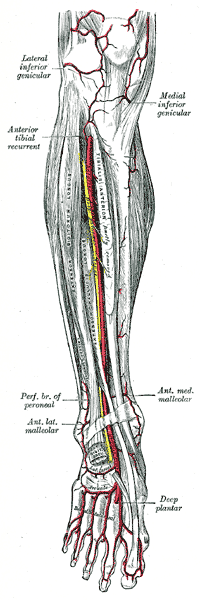In human anatomy, the dorsalis pedis artery (dorsal artery of foot) is a blood vessel of the lower limb. It arises from the anterior tibial artery, and ends at the first intermetatarsal space (as the first dorsal metatarsal artery and the deep plantar artery). It carries oxygenated blood to the dorsal side of the foot. It is useful for taking a pulse. It is also at risk during anaesthesia of the deep peroneal nerve.
| Dorsalis pedis artery | |
|---|---|
 Anterior tibial artery, dorsalis pedis artery and the muscles and bones of the leg (anterior view). | |
| Details | |
| Source | Anterior tibial artery |
| Branches | First dorsal metatarsal artery, deep plantar artery |
| Supplies | Dorsal surface of the foot |
| Identifiers | |
| Latin | arteria dorsalis pedis |
| TA98 | A12.2.16.048 |
| TA2 | 4714 |
| FMA | 43915 |
| Anatomical terminology | |
Structure
editThe dorsalis pedis artery is located 1/3 from medial malleolus of the ankle. It arises at the anterior aspect of the ankle joint and is a continuation of the anterior tibial artery.[1][2] It ends at the proximal part of the first intermetatarsal space. Here, it divides into two branches, the first dorsal metatarsal artery, and the deep plantar artery.[2] It is covered by skin and fascia, but is fairly superficial.[2]
The dorsalis pedis communicates with the plantar blood supply of the foot through the deep plantar artery. Along its course, it is accompanied by a deep vein, the dorsalis pedis vein.
Function
editThe dorsalis pedis artery supplies oxygenated blood to the dorsal side of the foot.[1]
Clinical significance
editPulse
editThe dorsalis pedis artery pulse can be palpated readily lateral to the extensor hallucis longus tendon (or medially to the extensor digitorum longus tendon) on the dorsal surface of the foot, distal to the dorsal most prominence of the navicular bone which serves as a reliable landmark for palpation.[3] It is often examined, by physicians, when assessing whether a given patient has peripheral vascular disease. It is absent, unilaterally or bilaterally, in 2–3% of young healthy individuals.[4]
Ultrasound
editThe dorsalis pedis artery may be studied using ultrasound.[2] Doppler ultrasound can be used to investigate blood flow.[2]
Local anaesthesia
editThe dorsalis pedis artery is at risk when injecting anaesthetic into the deep peroneal nerve.[5] Ultrasound can be used to help to avoid the artery.[5] The injection site is just lateral to the artery.[5]
References
edit- ^ a b Meyr, Andrew J.; Steinberg, John S.; Attinger, Christopher E. (2012). "3 - Vascular anatomy and its surgical implications". Lower Extremity Soft Tissue & Cutaneous Plastic Surgery (2nd ed.). Saunders. pp. 13–21. doi:10.1016/B978-0-7020-3136-6.00003-5. ISBN 978-0-7020-3136-6.
- ^ a b c d e Gaggl Sr., Alexander Johann; Borumandi, Farzad; Bürger, Heinz (2017). "42 - Other Free Flaps Used in Head and Neck Reconstruction". Maxillofacial Surgery (3rd ed.). Churchill Livingstone. pp. 584–615. doi:10.1016/B978-0-7020-6056-4.00043-5. ISBN 978-0-7020-6056-4.
- ^ Mowlavi, A; Whiteman, J; Wilhelmi, BJ; Neumeister, MW; McLafferty, R (2002). "Dorsalis pedis arterial pulse: palpation using a bony landmark". Postgraduate Medical Journal. 78 (926): 746–7. doi:10.1136/pmj.78.926.746. PMC 1757948. PMID 12509693.
- ^ Robertson, GS; Ristic, CD; Bullen, BR (1990). "The incidence of congenitally absent foot pulses". Annals of the Royal College of Surgeons of England. 72 (2): 99–100. PMC 2499134. PMID 2185683.
- ^ a b c Shastri, Uma; Kwofie, Kwesi; Salviz, Emine Aysu; Xu, Daquan; Hadzic, Admir (2014). "54 - Lower Extremity Nerve Blocks". Practical Management of Pain (5th ed.). Mosby. pp. 732–744. doi:10.1016/B978-0-323-08340-9.00054-2. ISBN 978-0-323-08340-9.
External links
edit- Anatomy figure: 12:04-19 at Human Anatomy Online, SUNY Downstate Medical Center - "Arteries of the lower extremity shown in association with major landmarks."
- Image at umich.edu
- http://www.dartmouth.edu/~humananatomy/figures/chapter_17/17-3.HTM Archived 2008-01-17 at the Wayback Machine